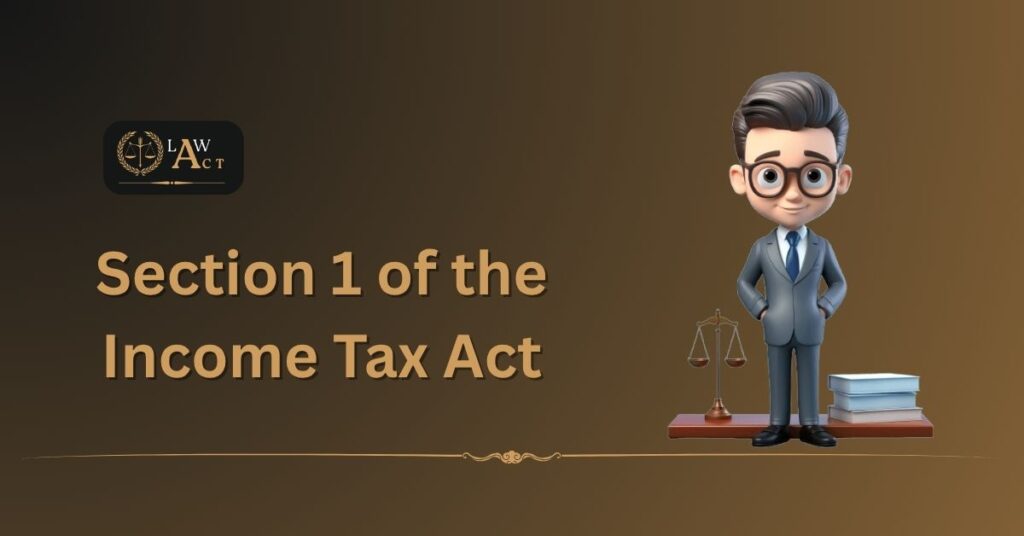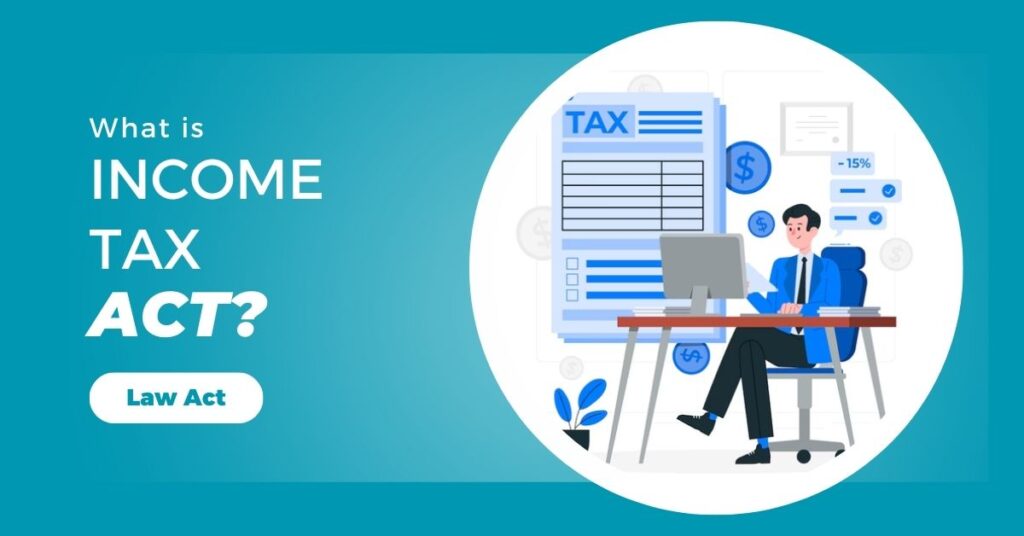When we talk about income tax in India, the law that governs everything related to it is the Income Tax Act, 1961. This law is vast and contains hundreds of sections that deal with every aspect of taxation. However, every big law starts with a simple beginning. In the case of the Income Tax Act, that beginning is Section 1.
What is Section 1 of the Income Tax Act?
Section 1 of the Income Tax Act may look very short and simple, but it holds great importance. It is the section that introduces the Act and sets the stage for everything that follows. In short, Section 1 defines three important things:
- Short Title of the Act
- Extent of the Act
- Commencement Date
Let’s understand each of these parts in detail.
1. Short Title of the Act
The first line of Section 1 says:
“This Act may be called the Income-tax Act, 1961.”
This line tells us what the law is officially called. It is important because many laws in India have similar names or deal with similar topics. The short title removes confusion. Whenever anyone refers to the Income-tax Act, 1961, they are referring to this specific law.
The name also includes the year 1961, which helps distinguish it from any older or newer income tax laws that may be created. Even though it was passed in 1961, the Act is still in use today, with regular updates and amendments.
2. Extent of the Act
The second part of Section 1 tells us how far this Act applies. It says:
“It extends to the whole of India.”
This means that the Income Tax Act is applicable across the entire country, including all states and union territories. It is a central law, which means it has been made by the Parliament of India and applies uniformly in every part of India.
Whether you live in Delhi, Kerala, Gujarat, or any part of the North-East, this law is applicable to you. This uniformity is very important in maintaining a single tax system for all citizens, rather than having different rules for different regions.
3. Commencement of the Act
The third and final part of Section 1 mentions the date on which the Act came into force. It states:
“It shall come into force on the 1st day of April, 1962.”
This means that even though the Act was passed in 1961, it became active and started working from 1st April 1962. This date is important because from that day onwards, all income tax matters in India started to be handled under this new law.
Before this, India had different laws and systems for taxation. The 1961 Act was created to simplify and unify the tax rules and procedures under one single framework.
Why is Section 1 Important?
Section 1 doesn’t talk about tax rates or exemptions. But its importance lies in the fact that it is the backbone of the entire Income Tax Act.
Here’s why Section 1 is important:
- It gives the law its identity by naming it.
- It sets the boundaries where the law applies.
- It tells us the starting point from which the law became effective.
Just like a building needs a strong foundation, a law needs a clear introduction. Without Section 1, there would be confusion about what the law is, where it applies, and from when.
Key Features of Section 1
| Feature | Details |
|---|---|
| Short Title | Income-tax Act, 1961 |
| Extent | Entire territory of India |
| Commencement Date | 1st April 1962 |
| Type of Law | Central Law passed by Indian Parliament |
Relation to Other Sections
Section 1 may be short, but it leads to all the other sections of the Act, which are many. Some important sections include:
- Section 10 – Exemptions from total income
- Section 80C – Deductions allowed for savings and investments
- Section 139 – Requirements for filing income tax returns
All these sections are based on the authority given by Section 1. Without Section 1, none of these provisions would have legal standing.
Historical Background
Before the Income Tax Act, 1961 came into existence, India followed the Indian Income Tax Act, 1922. That law was found to be outdated and complicated. It had many amendments and was difficult for common people to understand.
To bring clarity and make the tax system more efficient, a new law was proposed. This led to the drafting and passing of the Income-tax Act, 1961. A committee led by Nicholas Kaldor, a British economist, played a key role in reforming India’s tax structure.
This reform not only modernized the tax system but also made it more organized. Since then, the Act has undergone many changes, but Section 1 has always remained the same.
Impact on Taxpayers
Even though Section 1 does not mention anything directly about tax payments, returns, or penalties, it still impacts every taxpayer. It defines the law that governs how much tax we pay, how we file returns, and how we claim refunds.
So, if you are paying taxes today or filing returns through the Income Tax portal, you are doing it under the authority of a law that started with Section 1.
Understanding this base gives more confidence and clarity to anyone dealing with taxes.
Section 1 and Government Authority
Another reason Section 1 is important is because it gives the Government of India the power to collect tax from people and businesses. Without this section, the law would not have the authority to operate.
The power to tax is a serious one, and it must come from a clear and legal source. Section 1 is that source. It gives the government the legal backing to create rules, demand payments, give exemptions, and even impose penalties.
Is Section 1 Ever Amended?
Unlike other sections, Section 1 has never been amended since the Act came into force. That’s because it simply sets the title, extent, and commencement – all of which are permanent facts.
Other sections of the Act are amended regularly in Finance Acts passed each year. But Section 1 remains constant. It is the anchor that holds the law together.
Conclusion
Section 1 of the Income Tax Act may seem very simple, but it plays a powerful role in India’s legal and tax structure. It tells us what the law is called, where it applies, and when it started. Every Indian taxpayer is directly or indirectly affected by this section.
Understanding Section 1 gives us a better foundation to understand the rest of the Act. If you are trying to learn about income tax or just want to become a more informed citizen, start with the basics—and Section 1 is the very first step.
Also Read:
- Section 54 of Income Tax Act
- How to Register for VAT in UAE
- Income Tax Budget 2025: What’s New?
- Section 92BA of the Income Tax Act
- Income Tax Act eBook: Everything You Need to Know
Frequently Asked Questions
Why does Section 1 mention the year 1961?
The law was passed in 1961, which is why the name includes that year. However, it started being used from 1st April 1962. The year helps us identify which version of the law we’re talking about and makes it easy to refer to.
Does Section 1 apply all over India?
Yes, Section 1 clearly says that the Income Tax Act applies to the whole of India. This includes all states and union territories. No matter where a person lives in India, this law is applicable to them for income tax purposes.
Who created the Income Tax Act, 1961?
The Income Tax Act, 1961 was created by the Parliament of India. It replaced the older Income Tax Act of 1922. The new law aimed to simplify and modernize the tax system so that it could meet the needs of independent India.
Can Section 1 be changed or updated?
Section 1 is a basic introductory part of the law. Since it talks only about the law’s name, extent, and starting date, it has not been changed so far. Other sections may change often, but Section 1 has remained the same since 1962.
Why should normal people know Section 1?
Even if you are not a lawyer, understanding Section 1 helps you know when the law started and how it applies to you. It’s the first step in understanding your rights and responsibilities as a taxpayer under Indian law.
Is the law under Section 1 still active today?
Yes, the Income Tax Act, 1961 is still the main law used in India today to collect income tax. It is updated every year through the Finance Act, but its foundation, which starts with Section 1, remains the same and active.
Does Section 1 explain tax rates or rules?
No, Section 1 does not talk about tax rates, deductions, or returns. It only tells us what the law is called, where it applies, and from when. The tax rules and rates are explained in later sections of the Act.



